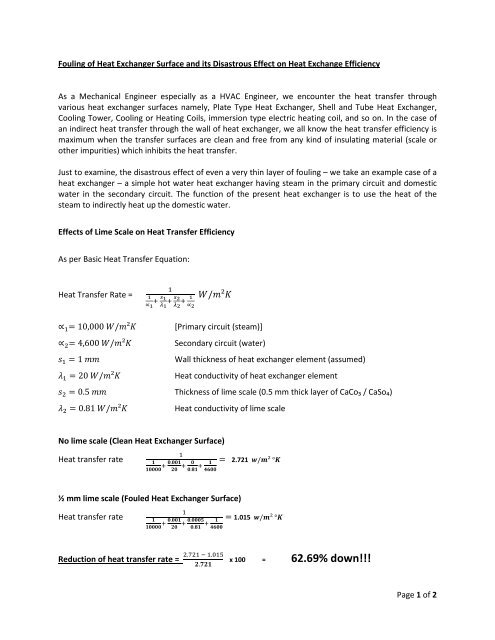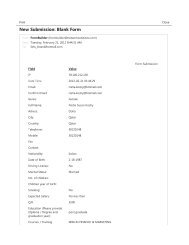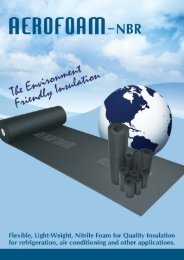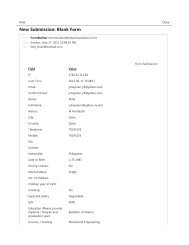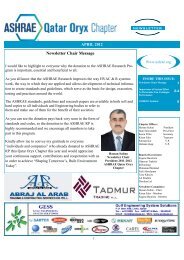Fouling of Heat Exchanger Surface and its ... - ASHRAE Qatar
Fouling of Heat Exchanger Surface and its ... - ASHRAE Qatar
Fouling of Heat Exchanger Surface and its ... - ASHRAE Qatar
You also want an ePaper? Increase the reach of your titles
YUMPU automatically turns print PDFs into web optimized ePapers that Google loves.
<strong>Fouling</strong> <strong>of</strong> <strong>Heat</strong> <strong>Exchanger</strong> <strong>Surface</strong> <strong>and</strong> <strong>its</strong> Disastrous Effect on <strong>Heat</strong> Exchange EfficiencyAs a Mechanical Engineer especially as a HVAC Engineer, we encounter the heat transfer throughvarious heat exchanger surfaces namely, Plate Type <strong>Heat</strong> <strong>Exchanger</strong>, Shell <strong>and</strong> Tube <strong>Heat</strong> <strong>Exchanger</strong>,Cooling Tower, Cooling or <strong>Heat</strong>ing Coils, immersion type electric heating coil, <strong>and</strong> so on. In the case <strong>of</strong>an indirect heat transfer through the wall <strong>of</strong> heat exchanger, we all know the heat transfer efficiency ismaximum when the transfer surfaces are clean <strong>and</strong> free from any kind <strong>of</strong> insulating material (scale orother impurities) which inhib<strong>its</strong> the heat transfer.Just to examine, the disastrous effect <strong>of</strong> even a very thin layer <strong>of</strong> fouling – we take an example case <strong>of</strong> aheat exchanger – a simple hot water heat exchanger having steam in the primary circuit <strong>and</strong> domesticwater in the secondary circuit. The function <strong>of</strong> the present heat exchanger is to use the heat <strong>of</strong> thesteam to indirectly heat up the domestic water.Effects <strong>of</strong> Lime Scale on <strong>Heat</strong> Transfer EfficiencyAs per Basic <strong>Heat</strong> Transfer Equation:<strong>Heat</strong> Transfer Rate =∝ ∝/²∝ = 10,000 /²∝ = 4,600 /² = 1 = 20 /² = 0.5 = 0.81 /²[Primary circuit (steam)]Secondary circuit (water)Wall thickness <strong>of</strong> heat exchanger element (assumed)<strong>Heat</strong> conductivity <strong>of</strong> heat exchanger elementThickness <strong>of</strong> lime scale (0.5 mm thick layer <strong>of</strong> CaCo₃ / CaSo₄)<strong>Heat</strong> conductivity <strong>of</strong> lime scaleNo lime scale (Clean <strong>Heat</strong> <strong>Exchanger</strong> <strong>Surface</strong>)<strong>Heat</strong> transfer rate . . = 2.721 /² °½ mm lime scale (Fouled <strong>Heat</strong> <strong>Exchanger</strong> <strong>Surface</strong>)<strong>Heat</strong> transfer rate . . . = 1.015 /² °Reduction <strong>of</strong> heat transfer rate =. ..x 100 = 62.69% down!!!Page 1 <strong>of</strong> 2
Let us pause for a second <strong>and</strong> just think – the drastic energy cost that we pay everyday for keeping ourheat exchange surface [or electric heater element] fouled!!!Therefore, it is important to select the right strategy <strong>of</strong> keeping the heat exchanger clean among thevarious alternatives available as follows:1. By putting a right maintenance regime to keep the heat exchanger surface always clean.2. Whenever possible selecting a shell <strong>and</strong> tube type heat exchanger with self-cleaning &performance enhancing smaller dia solid tabulator rods in the (tubes) secondary (moremaintenance prone) side. The shell <strong>and</strong> tube heat exchanger has got an advantage <strong>of</strong> easymaintainability <strong>and</strong> cleaning possibility by simply opening the terminal flanges. Also it isimportant to choose the durable, tough material e.g., austenitic stainless steel SS316Ti – soeven if the surface is fouled – it can be cleaned thoroughly & regularly.3. Possible introduction <strong>of</strong> an online centrifugal filtration system up-stream to a heatexchanger (especially plate & frame type) if the fluid h<strong>and</strong>led is having a substantial solidsuspended impurities.In short, the key to maintain the efficiency <strong>of</strong> a heat exchanger is to keep the surface clean bywhatever means <strong>and</strong> if we can do that, we can save a lot <strong>of</strong> energy <strong>and</strong> cost silently.Article from:Eng. Subrata KarMember – <strong>ASHRAE</strong>, VP – BOGChair-membership PromotionPage 2 <strong>of</strong> 2


